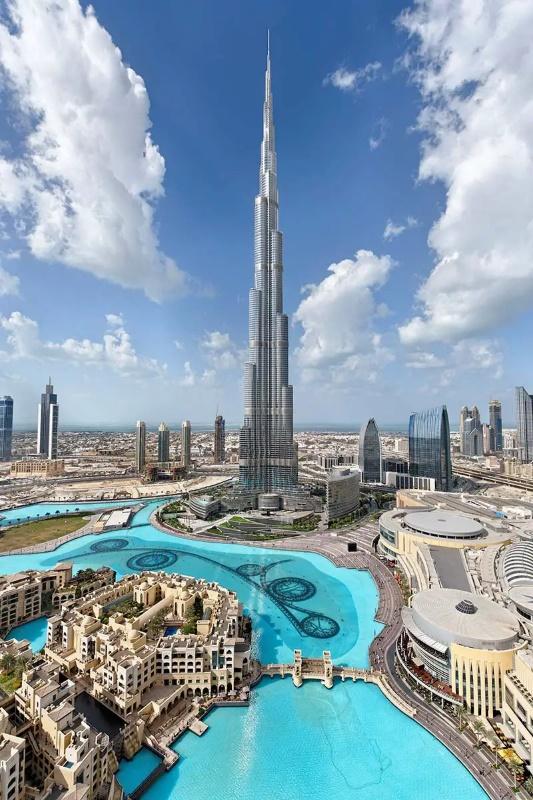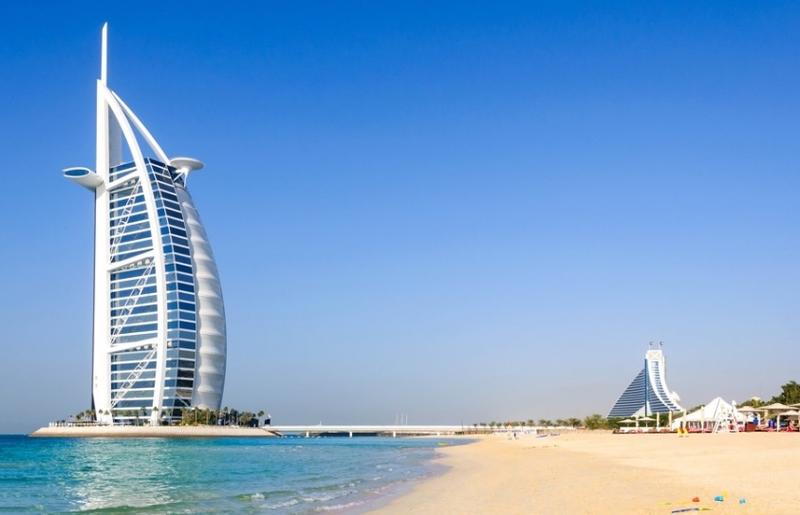UNITED NATIONS FRAMEWORK CONVENTION ON CLIMATE CHANGE
Report on COP 28 in DUBAI, UAE
Thomas J. Grant PhD, PE
This document is a summary of my conversations and observations, plus announcements and news events associated with COP 28, which took place from November 30th to December 12th, 2023 in the Emirate of Dubai. I was sponsored by the American Nuclear Society, so there is a nuclear focus to this report, but my personal bias is that I don’t care which technology is used as long as it works to mitigate climate change. To quote one of the youth groups at the conference, “Together is Better.” This is also not intended to be a comprehensive account of everything that went on at COP 28.
BACKGROUND. The UNFCCC was formed in 1992 to serve as a platform for international negotiations on climate change. The annual Conference of Parties (COP) serves as the primary negotiation and decision-making process within the Framework. Its decisions can be the basis for a treaty or international law. COP is comprised of representatives of the 193 member nations of the United Nations, plus non-voting members of invited NGOs, observers, technical experts, and the media. The first COP was held in Bonn, Germany in 1995, and has been held, for the most part, annually since then. The most notable decisions to come out of this process have been the Kyoto Protocol and the Paris Accords.
Kyoto Protocol, agreed to in 1997 as part of COP 3, set a legally binding greenhouse gas emission reduction targets for a group of 41 industrialized countries, plus the European Union. The US Senate never ratified it so it was not legally enforceable in the US. Beginning in 2005, it required the Annex I countries to reduce their emissions to below those of 1990, but allowed emissions trading between countries and gave credit for investments in clean energy in emerging economies. In the first reporting period, 2008 – 2012, most of the Annex I countries met their targets, but global emissions still increased because emissions from emerging countries increased, including China and India, two of the world’s largest polluters. Goals for the second period, 2013 – 2020, were set by the Doha Amendment. This agreement quickly fell apart as several countries withdrew, and confusion reigned regarding the former Soviet Republics. The Kyoto Protocol did set the stage for the Paris Accords.
Paris Agreement (or Accords in French) signed in 2017 at COP 21, set a goal of limiting global warming to well below 2 degrees C above pre-industrial levels, and preferably limiting it to 1.5 degrees C. All but 3 UN members ratified it. The US withdrew in 2020 but rejoined in 2021. Every Party to the Agreement, including emerging countries, submits a voluntary plan and goal, which have political implications, but are not legally enforceable. A framework was established that required all Parties to report their emissions which are reviewed by technical experts. To meet this goal, global emissions should be net zero by 2050. The Parties also commit to preserving the world’s forests, wetlands, and oceans. Developed countries would provide financial support to emerging countries, and it recognized the concept of a loss and damage fund to be established later for vulnerable nations. The voluntary nature of the goals and lack of enforcement is a criticism, but it does give us a global accounting system, referred to as the Global Stocktake.
COP 28 was held in Dubai in the United Arab Emirates, attended by 85,000 participants. Attendance included 33 heads of state, plus royalty like King Charles III of Britain. The Pope intended to come, but had to excuse himself due to sickness. The US delegation was represented by Kamala Harris and John Kerry. The CEO of Exxon attended, the first time an oil CEO has ever attended a COP. The venue was the 1,100-acre Exposition complex built for EXPO 2020. There were 198 “Parties” in attendance to include the 193 UN member nations, plus some observer states like the Vatican and the European Union. The venue was divided into Blue and Green Zones. The Blue Zone was for the formal negotiations among the parties, plus country pavilions and side events. The Green Zone was more inclusive to include pavilions hosted by companies, various organizations, and private parties showcasing their ideas and technologies. I had Green Zone access, but had many opportunities to speak to Blue Zone delegates.
CONFERENCE OF PARTIES COP 28
Why Dubai? The first criticism of the COP was why hold it in an oil rich nation? This was combined with the host, Sultan Al Jaber, President-designate of COP 28 and CEO of the United Arab Emirates (UAE) oil company, losing his cool in a press conference when pressed on a phase out of fossil fuels. His angry reply of claiming no scientific evidence to support a phase out, and talking about going back to living in caves was unfortunate. Yes, the UAE is the 7th biggest oil exporter in the world, but to be fair they also have more carbon free energy per capita than any other country in the world. Dubai has the largest solar park in the world, 3.5 GW plus another 1.8 GW addition by 2030. The solar park includes a 250 MW molten salt thermal tower that has the ability to produce electricity at night. They are building a 250 MW hydro plant to come online by 2025, and a 4th nuclear plant to come online in 2024 giving them a total of 5.6 GW of nuclear. The UAE presently has 27 GW of clean energy with a population of only 9 million. They have committed $54 B to triple renewable and nuclear energy. They are decarbonizing their steel, aluminum, glass, and concrete production facilities, with a goal of 40% reduction by 2030. Dubai Holding Company, a highly capitalized investment company, will invest in only green projects. Dubai has pledged to lower carbon emissions 30% by 2030 and be net zero by 2050. Many other countries have made similar pledges, but from what I saw in Dubai, my feeling is that Dubai can not only talk the talk, but they can walk the walk.
Loss and Damage Fund. The opening plenary session approved the structure of a Loss and Damage fund that has been discussed for many years. This would be funded by the wealthier countries to help poorer countries deal with climate change. The UAE immediately pledged $100M followed by an equal amount by Germany. Italy and France both agreed to contribute $108 M. The US pledged $17.5 M, which was criticized as paltry. The problem for the US is that China, which is the largest greenhouse gas emitter, says they won’t contribute since they are a developing nation, and they even maintain that they should be eligible for some of the funds. I was told that if China gets to take money from this fund, it would create a political storm in the US. At the end of COP 28, $700 M had been pledged, but everyone agrees this is a small percentage of expected climate damage.
1.5 Degrees Celsius (2.7 Degrees Fahrenheit). The year 2023 turned out to be the hottest on record in modern history, and most likely the hottest going back 125,000 years into the Pleistocene epoch. As of November, the earth was 1.46 degrees C hotter than pre-industrial era. As I write this on January 1, 2024, my daughter is complaining that the skiing in Vail, Colorado is poor because of the lack of snow. We are literally hanging by our fingernails to meet the goal of the Paris Accords of 1.5 degrees C. I talked to a large number of people at COP 28, but couldn’t find anyone who was optimistic about meeting the 2050 goal. Most said we were going to blow right past it so fast that even the 2 degrees C backup goal is questionable. The COP 28 pronouncements; however, still espouse the 1.5 C goal. To meet this goal, global emissions need to be reduced by 45% by 2030 and reach net zero by 2050. While 145 countries have either pledged or are considering meeting these COP emissions requirements, several countries say they won’t meet the 2050 date, including China (2060), Brazil (2060) and India (2070). Looking at the graph below, you can see why, in spite of the growth of renewable energy, there has been a steady increase in global carbon emissions for the last 30 years, primarily due to the expansion of the Chinese economy and its reliance on coal. China has more than 1,200 operating coal plants, and in 2022 permitted 2 new coal plants every week. China is now responsible for almost one third of all global carbon emissions. Two delegates told me that if we can’t get China to stop building coal plants, we may hit 2.5 C!
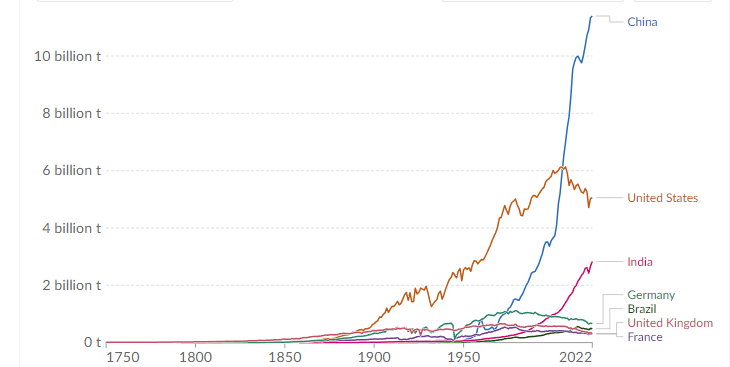
Data source: Global Carbon Budget (2023) – Learn more about this data OurWorldInData.org/co2-and-greenhouse-gas-emissions | CC BY
The Triple Pledges. Eary in COP 28, it was announced that 118 countries had pledged to work together to triple the world’s installed renewable energy generation capacity to at least 11,000 GW by 2030, and to work together to double the rate of annual energy efficiency improvements from 2% to 4%. There are many suggested actions in this pledge, but two I thought most significant were to speed up the permitting process for these projects, and to develop and expand grid connections. The second pledge, led by the United States and announced by John Kerry, was signed on by 22 countries to triple global nuclear power from a base year of 2020 to 2050. This pledge “recognizes the key role of nuclear energy in achieving global net-zero greenhouse gas emissions by 2050 and keeping the 1.5-degree goal within reach,” the US Department of Energy said in a statement. Prior to this announcement, nuclear power capacity was expected to rise by 50% over the same time period. Both of these pledges seem to me to have some serious barriers to overcome.
Finance. Everyone I talked to at COP was very complimentary of President Biden and his $1.5 T Inflation Reduction Act that provides money for a variety of renewable energy projects. Many Europeans told me that they wished the European Union would do something similar. There were a very large number of financial institutions showcasing in the Green Zone, reflecting the fact that there is a large amount of money being spent in this arena. It was estimated at COP that $1.5 T per year would be needed to decarbonize the energy sector; however, Wood McKenzie, a financial consulting firm, estimated that it would take $1.9 T per year to meet the 2 degrees goal rising to $2.7 T per year to meet the 1.5 degrees C goal. I asked the question if there was enough capital available in the global markets, and was assured that there was. Later, I was told by a consultant to several African financial ministers, that my question had the wrong construct. He said the real question is how much of that money would be “sent south,” i.e. to poorer countries. He challenged me to look at the situation in Africa. I did and my findings are covered below.
Africa has 1.47 B people of whom 1.1 B live in sub-Sahara Africa which is the poorest region in the world. The United Nations classifies less developed countries (LDCs) based on Gross National Income per capita, human conditions like health, food, and literacy, and economic vulnerability. Sub-Saharan Africa contains 33 of the 42 countries listed as LDCs in the world by the United Nations, and a third of the people in this region live in extreme poverty. About 600 M have no electricity at all. There is great potential for solar, wind, geothermal, and hydropower, but the electric grid is not up to modern standards, and would have to be rebuilt in most areas to accommodate any large projects. Fossil fuels account for about 79% of electricity production, with hydropower being the largest renewable at 15%. Off-grid energy for transportation, heating, and cooking is supplied by oil and biomass. Africa gets 45% of its primary energy from biomass including wood, charcoal, and bagasse for heating and cooking. My African consultant is correct. Africa, especially sub-Saharan Africa, cannot meet any of the net zero goals without massive financing from the developed countries.
Bias for Solar and Wind. Previous COP documents have emphasized wind and solar as the solution to climate change. While wind and solar have made remarkable contributions in recent years, the consensus at COP is that it is not enough, and the world needs to do much more. If you look at the graph below, it is clear that we need all the carbon free tools in our toolbox including hydropower, nuclear, carbon capture, biomass, energy efficiency, and clean hydrogen. At COP 28, there was a push by various groups to acknowledge the need for nuclear power and other technologies in the electrical generation mix.
Previous UN documents have taken pains not to mention nuclear or hydropower. To give an example of this, I talked to a delegate from Tajikistan, whose energy is 98% renewable, consisting of almost all hydropower. He explained that Tajikistan is a very mountainous country, and they have abundant potential for even more hydropower. They would like to build more and sell the excess power to neighboring countries as an economic opportunity. He said that several groups at COP congratulated him on his country’s carbon free status, but they also told him it was a bad idea to build more hydro because it was not environmentally sensitive. His response was, “Hydropower is what we have, how can it be a bad idea for climate change to build more?”
Nuclear. I attended events at the Net Zero Nuclear pavilion as well as an offsite conference entitled the First Net Zero Nuclear Summit. Let’s start with some facts. There are 436 operating nuclear power plants in the world and another 60 under construction, representing a total of 455 GW of capacity. In 2022, nuclear power produced 2,680 TWHr of electricity avoiding a Giga ton of carbon dioxide emissions. When comparing the installed capacity of various fuels versus the electricity produced, you have to consider the capacity factor, i.e. the equivalent percent time the plant produces its nameplate electrical capacity. Capacity factors for US power plants in 2022 include 92.7% for nuclear, 37% for wind, 35.9% for Hydro, and 24.4% for solar. World figures are harder to obtain.
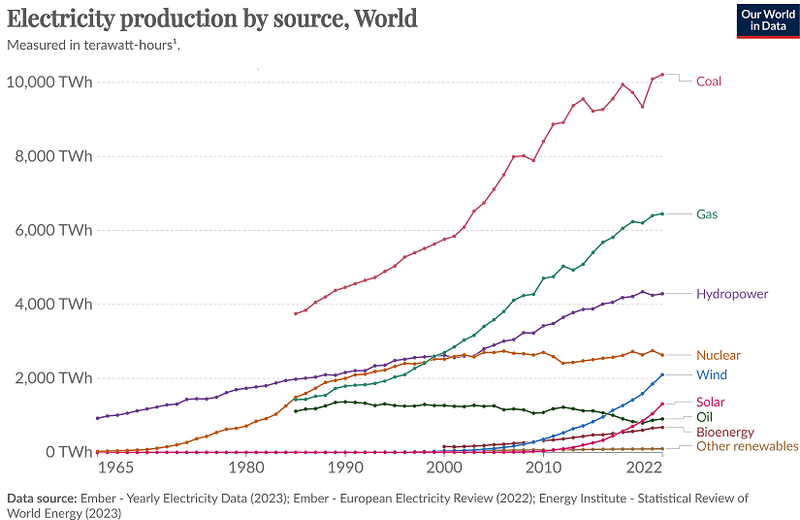
As shown in the graph above, the two most successful fuels to date for avoiding global greenhouse gas emissions are hydropower and nuclear. Since 2000, nuclear has produced 8.7 times the electricity as solar and 4.7 times the electricity as wind. In fact, nuclear has produced more carbon free electricity in the last 22 years than solar and wind combined. Nuclear has avoided 22 GT of CO2 emissions. The irony of this is that COP and other organizations continue to downplay these important sources of clean energy. I want to emphasize that nuclear is not in competition with solar, and that any clean source of energy is good. It is also apparent that wind and solar will pass nuclear in a few years, which is fine. The earth does not care how we avoid CO2, only that we do so.
Speakers at the conference emphasized that there has been a shift in the public approval of nuclear, especially among the younger generation. There was a special emphasis on youth at COP 28, and many youth groups were recognized to include N4C, Nuclear for Climate. Grace Stanke, reigning Miss America and a nuclear engineering student at the University of Wisconsin, was a participant. I should point out that the UN includes anyone under the age of 35 as a youth. I have to admire the younger generation for their enthusiasm, energy, and ability to let go of established doctrine. It is not a scientific sample, but many of the younger generation I talked to were pro-nuclear. I would also note that there was an anti-nuclear demonstration at the entrance to the Blue Zone one morning, comprising mostly young people. At the other end of the age bracket, Oliver Stone, producer of many documentaries, gave an impassioned pro-nuclear speech.
Small Modular Reactors (SMR). Nuclear power plants have had issues with high capital cost, long construction time, and cost overruns. It is thought that smaller modular reactors between 30 -300 MW could address these issues. Three small modular reactors (SMRs) were operational in 2022, located in Russia, China, and India. Three more were under construction, while 65 SMR concepts are in the design stage. Most of them have a design capacity of between 100 and 300 megawatts. There was a lot of interest at COP 28 in SMRs with the hope that they could bring on a new market for nuclear quickly enough to make a difference in climate change. The next 5 years will be critical to get cost and operational data sufficient to attract customers. I heard both optimistic and more sobering views regarding their probability of success at COP.
I met a delegate who was in the German parliament and I chided him for Germany closing all their nuclear reactors and replacing them with coal and gas. He agreed that was bad for climate change, but he said that in a democracy to go forward, you need a “social license”. At that time, the Green Party was in ascendency, and the governing coalition needed to give them something. Many people, even some Green Party members, agree it was a mistake, but the Green Party is unalterably anti-nuke because that doctrine is in their founding constitution. Both Germany and Austria will remain off-limits for nuclear.
Denmark is a renewable energy success story. Offshore wind delivers excess power in windy conditions, but the weather system results in weeks of no winds. Denmark makes up the difference with coal and wood chip biomass from the US and the Balkans. However, it turns out that the wood suppliers are clear cutting mature trees and there has been a scandal with the sustainability credits. It was reported that there has been a land shift in public opinion in favor of nukes, even though a ban on nuclear remains.
Sweden’s grid was carbon free in 1985 using hydro and nuclear plants. Due to environmental concerns, no new hydro plants were built and several nuclear plants were phased out. For the last 8 years, wind power has taken up the slack. In 2010, parliament changed the policy of phasing out nuclear, and just a month ago they issued a new energy policy with an emphasis on nuclear, including 2 new reactors by 2035 and 10 new reactors or equivalent with SMRs by 2045. Sweden has also sited a nuclear waste repository. Another Scandinavian country, Finland has shut off some hydro plants to save biodiversity, and has made up for it with nuclear. They have licensed the world’s first nuclear waste repository for spent fuel.
Australia presently has a ban on nuclear, but I was told by an Australian delegate that this represents the power of the coal industry as Australia is one of the world’s largest coal exporters. California also has a ban on nuclear plants, with its last plant, Diablo Canyon, scheduled to close in 2025. With a swell of grassroots support and the backing of Governor Newsome, a bill was passed that will allow the plant to stay in operation. I talked to a student activist at COP who explained to me the long fight to keep the plant. A factor in the debate was that of the 50 states, California has the worst electrical grid in terms of reliability and stability.
One last nuclear story. The Green Zone had a pavilion called Pleistocene Park (a play on Jurassic Park). A Russian named Nikita Zimov is trying to reintroduce Pleistocene fauna to the Siberian steppes on the theory that this will restore highly productive grazing ecosystems in the Arctic, similar to the mammoth steppe ecosystem, which was dominant in Eurasia in the late Pleistocene. Several ecological mechanisms allow grazing ecosystems in the Arctic to have a cooling effect on the climate and also have the ability to protect Arctic permafrost from degradation. Pleistocene Park consists of 20 square kilometers in far northeastern Siberia. Nikita told me that his research facility is heated by a nuclear power plant, but that he has had several comments from attendees that this is a bad thing and he needs to change to solar or wind. He exploded, “Do you know what it is like to live north of the 68th parallel? I am 200 km north of the Arctic Circle. It gets to –50 F with no sun for 4 months of the year, and wind turbines ice up. If it wasn’t for the nuclear plant at Bilibino, I would have to give up on my father’s dream and abandon this project.”
Electric Vehicles. There were several vendors of European automobiles showing off their latest EVs to include new charging systems that looked similar to Tesla fast chargers. I asked how the market for EVs in Europe was doing, and I got the answer that 2024 would be a slower year. He noted that VW, Toyota, Honda, GM, and Ford had already reduced their sales forecast, but even with this forecast, they expect EV sales to grow around 12% in 2024.
The automakers’ models looked like what you would expect, but it was Dubai that really surprised me. Dubai is using battery powered heavy tractor trailers, speedboats for their Coast Guard, and police cars. In addition, an electric snowblower and a small backhoe were showcased. The heavy tractor trailer was the most impressive. It is not meant for highway driving but as a mechanism to move shipping containers and other heavy material around in their port. It takes about 90 minutes to fully recharge using a 600-volt charging system. They have just completed a trial with 3 of them, and they expect to replace or retrofit their fleet of 900 heavy trucks at their shipping terminal by 2030. The electric police cars are made by Audi and have a 300-mile range and an 800-volt fast charging system.
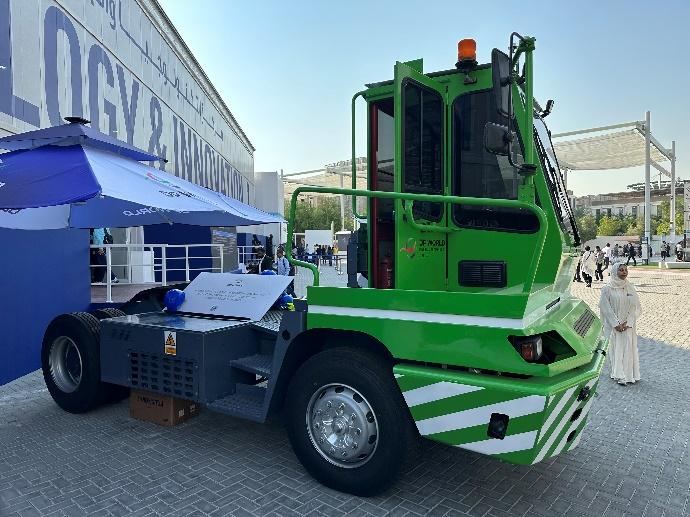
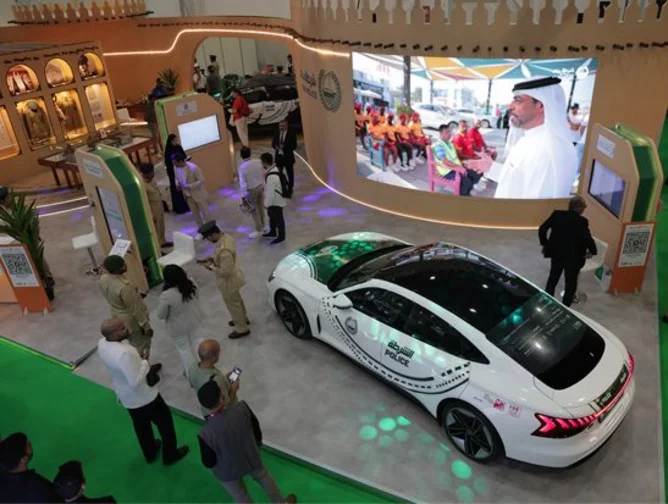
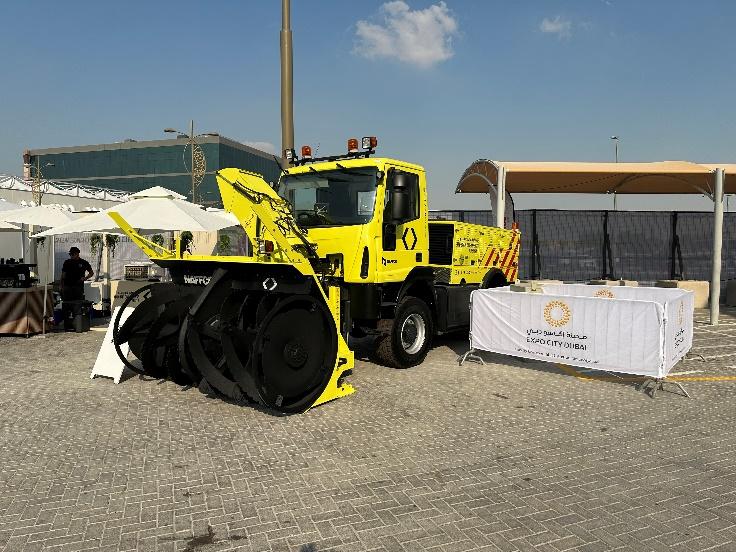

Carbon Capture. At least 4 vendors displayed their carbon capture technology, hoping to attract investors. One believes that their technology will produce a rock suitable for the geology of Dubai. While carbon capture has set off interest, there is no commercial project ongoing at present.
Wind and Solar. These are the technologies favored by most of the UN documents, but there were no solar companies and only one wind company with a pavilion in the Green Zone. Perhaps because these are more mature technologies that do not need to be introduced. I asked several Europeans how the wind energy market is doing. They said that higher costs, rising interest rates, and supply chain problems have depressed the market for the last three years with lower sales. In addition, lower cost Chinese turbines have hurt European turbine manufacturers enough that the European Union is considering action. I told them in the US our onshore market is booming with the only problem being the electrical grid. Offshore, we have only managed to install 7 turbines in the last 8 years for a total of 42 MW. The reason being local opposition and the lengthy permitting process. President Biden in 2020 announced an ambitious offshore program that has been tied up in knots by local political pressures. Just when the permitting log jam seems to be breaking, recently rising costs have caused several planned wind farms to be canceled or rebid to allow for rising costs. Orsted pulled out of 2 New Jersey planned projects saying the price made the projects no longer viable, and developers in Massachusetts have told the state they need to rebid two projects at a higher price. However, two projects, Vineyard Wind off Massachusetts and South Fork Wind off New York, are under construction and plan to deliver power in 2024. These permitting and pricing problems will probably be sorted out in the coming years.
Everyone I talked to, on the other hand, agrees that the global solar market is doing quite well. Predictions are for a double digit increase in sales for the next 5 years. Both large scale and rooftop installations are increasing, but the larger utility scale projects dominate because of their lower cost. Right now, China controls over 80% of panel manufacturing and over 90% of the supply chain, which is a concern for everyone.
On a lesser note, more than 25 years ago I was involved in a solar project for Saudi Arabia. You would think that the Mideast would be a good location for solar PV panels. The problem was that the Saudi coast was beset by windblown moist sand that quickly coated the panels. After three months, if you didn’t clean them, they would be seriously degraded. The only thing available to clean them was water, which is the one thing that is not plentiful in Saudi Arabia. We ended up installing smaller panels in the mountains for telecommunication and traffic signs, and where the humidity was much lower so the sand did not stick as badly. Talking with several DEWA employees (the Dubai company that operates the solar park), I asked them how they solved this problem for their large solar farm. They showed me that each row of solar panels has a robotic rolling dry scrubber that, on command, will proceed down the row of panels on a track, and clean them of any accumulated dust. Clever.
FINAL OUTCOME COP 28. A summary of pledges made by the parties at COP 28 is shown in the table below:
| Pledges | Signatories | Detail |
|---|---|---|
| Global Renewables and Energy Efficiency Pledge | 130 countries | Work to Triple Renewable Energy Generation to 11 TW by 2030, double annual energy efficiency improvements to 4%, prioritize energy efficiency |
| Net Zero Nuclear Industry Declaration | 25 countries | Triple nuclear capacity by 2050 |
| COP28 UAE Declaration on Hydrogen and Derivates | 37 countries | Work towards mutual recognition of renewable and low carbon hydrogen certification schemes |
| Oil and Gas Decarbonization Charter | 50 Oil Companies | Net zero by 2050, zero out upstream methane emissions by 2030, eliminate routine flaring |
| Industrial Transition Accelerator | 35 companies, six industry associations | Catalyze decarbonization in heavy emitting industry via green hydrogen, Carbon Capture Storage and Reutilization |
| Green Hydrogen and Green Shipping | 22 shipping and hydrogen companies | Produce 11 M tons low emission marine fuels by 2030 |
| Battery Energy Storage Systems (BESS) Consortium | 11 countries plus several banks | To deploy 5 GW on battery energy storage by the end of 2024, 90 GW goal by 2030 |
A final document entitled Outcome of the First Global Stocktake, the terminology of which was established in previous COPs, was approved by the Parties during an overtime session needed to get a consensus. The Stocktake re-affirmed the goals of The Paris Accords specifically to keep global warming to 1.5 C and for each of the parties to come up with a plan of action called nationally determined contributions (NDC) to meet this goal. The document contains 196 carefully worded paragraphs to achieve the goal of producing a document that says something, but with enough leeway in interpretation and without mandatory actions or enforcement, so all the parties could sign. I feel paragraph 28 is the important one reproduced below:
28. Further recognizes the need for deep, rapid and sustained reductions in greenhouse gas emissions in line with 1.5 °C pathways and calls on Parties to contribute to the following global efforts, in a nationally determined manner, taking into account the Paris Agreement and their different national circumstances, pathways and approaches:
(a) Tripling renewable energy capacity globally and doubling the global average annual rate of energy efficiency improvements by 2030;
(b) Accelerating efforts towards the phase-down of unabated coal power;
(c) Accelerating efforts globally towards net zero emission energy systems, utilizing zero- and low-carbon fuels well before or by around mid-century;
(d) Transitioning away from fossil fuels in energy systems, in a just, orderly and equitable manner, accelerating action in this critical decade, so as to achieve net zero by 2050 in keeping with the science;
(e) Accelerating zero- and low-emission technologies, including, inter alia, renewables, nuclear, abatement and removal technologies such as carbon capture and utilization and storage, particularly in hard-to-abate sectors, and low-carbon hydrogen production;
(f) Accelerating and substantially reducing non-carbon-dioxide emissions globally, including in particular methane emissions by 2030;
(g) Accelerating the reduction of emissions from road transport on a range of pathways, including through the development of infrastructure and rapid deployment of zero-and low-emission vehicles;
(h) Phasing out inefficient fossil fuel subsidies that do not address energy poverty or just transitions, as soon as possible;
While parties are obligated to submit an NDC, and to pursue measures to achieve it, the NDC is not a legally binding or enforceable commitment. Every 5 years there is a review by technical experts of each party’s progress on their NDC. The next review of NDCs is 2025 which would be COP 30.
It can be seen from item (e) above, that nuclear, carbon capture, and hydrogen made it into the document for the first time. Unfortunately, hydropower did not.
COP29. Next year 2024 in Azerbaijan.
The Emirate of Dubai. I would be remiss if I didn’t say something about the city of Dubai. It is a city of sumptuous wealth and unique one-of-a-kind features. You might say “What do you expect with all that oil wealth?” But you would be wrong. Most of UAE’s oil wealth is controlled by the emirate of Abu Dhabi, and oil contributes only about 5% to the economy of Dubai. The sultans have fashioned an economy that is based on finance, insurance and banking (think Switzerland without the mountains), real estate (think New York without the grime and crime), tourism (think Vegas without the vice), import/export (think Hong Kong without communism), tax haven (think Cayman Islands but 130 times bigger), high technology (think the Bay area but warmer), luxury goods (think Rodeo Drive on steroids), and finally an air and sea transportation hub to the Mideast (think Miami without the cruise ships).
They have one of the fastest growing economies in the world, which is impressive for a city/emirate that has only 3.6 M people. It is an Islamic country, but allows Western dress and lifestyles with some strictures on public behavior. They like to be number one in the world. Dubai International Airport is now number 2 in the world but is expected to overtake Atlanta by 2030. Their international terminal is the largest in the world, and once was the largest building of any kind in the world. Combined with the nearby Al Maktoum International Airport, they have the largest air hub in the world. Burj Khalifa is the tallest building in the world at 160 stories. They have more 5-star hotels in the world than any city except London. The Burj Al Arab Hotel is the most expensive in the world. You can have the Royal Suite for $25,000 a night with access to a cantilever helicopter pad on the 60th floor. The Jebel Ali port is the largest man-made port in the world and the busiest in the Mideast. The Palm Jumeirah Island is the largest man-made island in the world. The list goes on, and of course Dubai isn’t perfect, but I would like to close with three vignettes.
Dubai is one of the safest cities in the world. I talked to a nurse from London who has worked in Dubai for 7 years. She told me that she once accidentally left her purse in a bar in one of the hotels. She came back two days later and there it was, exactly where she had left it. Nobody had touched it.
I work as a paleontologist for the University of Kansas. A T rex named Stan, one of the largest and most complete dinosaurs ever found, was to be auctioned off by Christie’s in New York, a few years ago. I attended the auction. Stan went for $32 M which was an astounding sum and a record by a factor of 4 for a fossil. For 2 years the buyer was a secret, until it was revealed that it had been purchased by Dubai to be exhibited in their science museum. The exhibition is now under construction.
I had a chance to visit the Dubai Mall, the largest in the world. On the roof, it has tennis, basketball, volleyball, and badminton courts, plus a cricket pitch. Inside it has waterfalls, an aquarium, and a regulation sized ice hockey rink. I stopped to watch the skaters. As expected, most skaters were not very good, but there was one woman figure skater who was amazing. She was doing spins, leaps, and double axels with precision and grace. The more I watched, my evaluation of her went from great to world class to Olympic class. I pointed her out to someone who was a native Dubaian. He confirmed my evaluation by revealing that the mall periodically hires world class skaters to come in and just skate around with the locals. He concluded with, “In Dubai, we like to do everything first class.”
Yes, they do! And I am willing to bet they will meet their net zero carbon pledge by 2050.
